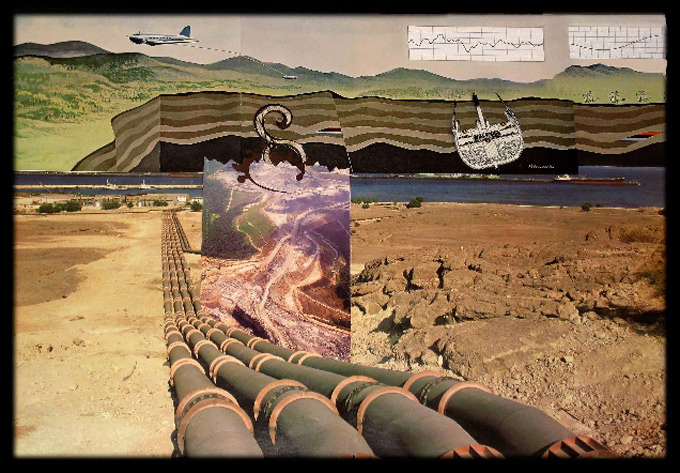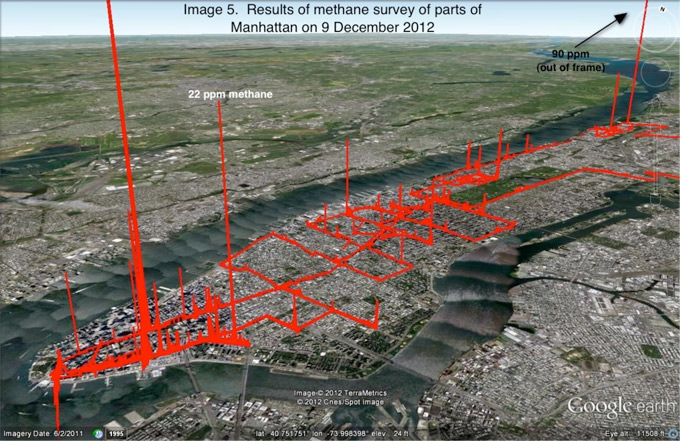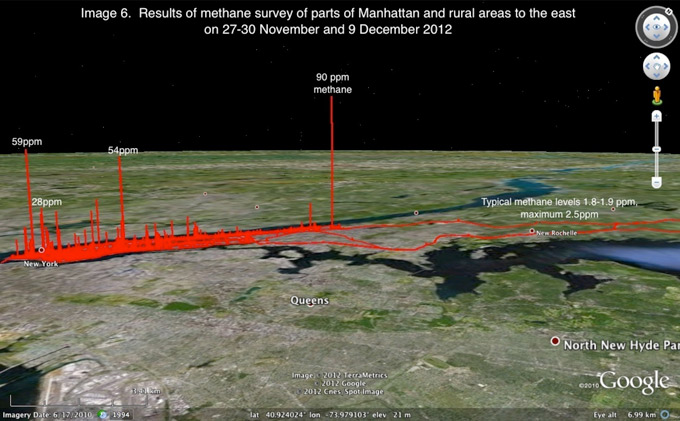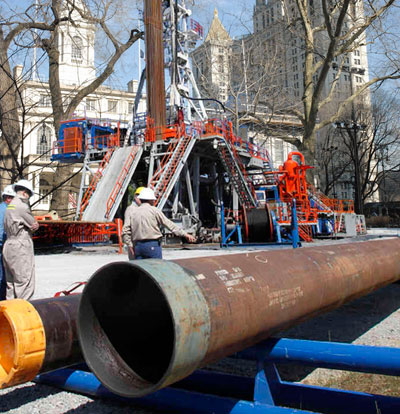
Christy Rupp, Exploit/Exhale, 2010. Included in the Cooper Union exhibition “Emissions: Images from the Mixing Layer” as part of Marfa Dialogues/NY.
The gas and oil industry would like to craft a wholesome image of natural gas as a clean resource and a “nonfossil” fuel. Neither of these characterizations is accurate. Yes, gas does burn with a nice blue flame at the end user’s stove. However, getting that gas to the stove is seriously contaminating our air and water. This is because pumping it in means using high-volume, slick-water hydraulic fracturing, or fracking. Unbeknownst to many, the process has profound health and environmental impacts. Thanks to aged and faulty infrastructure, often built on the cheap and left unchecked for years, gas inevitably leaks on the way from wells to pipelines. Add up all the dangers along the way, and one will soon find that gas has a larger global climate impact than oil or coal. Actual measurements of methane leakage have not been included in the accounting of greenhouse gas levels by the Environmental Protection Agency (EPA). Instead—whether because it lacks the necessary technology to test leak rates or because of political pressure—the agency generally uses emission estimates compiled by the gas industry. As a result, government policies regarding greenhouse gas emissions have been based on false data about the impact of natural gas.
Fossil fuel companies employ elegant advertising and cultivate ignorance as a strategy to support their position that fracked gas is safe and clean. They have succeeded in suppressing information about health conditions brought on by fracking in numerous ways. Gas companies regularly force impacted people to sign nondisclosure agreements as a condition of receiving settlements for damages caused by fracking in their neighborhoods. And for several years the entire industry has been exempted from major portions of protective laws like the Clean Water Act, the Clean Air Act and the Safe Drinking Water Act, thanks to sections of the 2005 Energy Policy Act that have come to be known as the Halliburton loophole. In effect, the exemptions release companies from liability for damages that their executives knew their operations would cause.

From mostly undisturbed sage and grassland in 1986, the Jonah gas field in the Upper Green River Valley, Wyoming, became a grid of three-to-four-acre gas pads by 2006. The area shown in each image is about seven miles across. Photo credit SkyTruth.org.
What led the oil and gas industry to frack in the first place? As conventional natural gas reservoirs were depleted, the industry realized that it had to go deeper into the ground to find this prehistoric fossil fuel, which was formed from plants and animals hundreds of millions of years ago. Today’s extraction technologies do not simply pump gas from an underground reservoir; rather, they use highly toxic chemicals to break up deep shale rock formations. Fracking requires drilling, both vertically and horizontally, often over a mile into the earth, to reach a shale layer that is then bombed—sometimes using depleted uranium—to release bubbles of gas from the shale rock formations. As a result of this process, air, land and water alike are contaminated.
You may have seen the image of a flaming faucet, made famous by Josh Fox’s documentary Gasland. Those flames in the water are actually burning methane (the main component of natural gas) that has migrated through underground fractures to reach aquifers, the water sources that lead to our faucets. Independent hydrogeologists warn that migration will inevitably pollute water—it’s just a matter of when. But migration is not the only way methane gets into our water. It also leaks through the one-inch cement casings that surround pipes channeling gas from wells to the surface, which are liable to crack and break under pressure or from improper installation.
Methane leakage not only adds to water contamination but also fundamentally contributes to global warming since methane is a highly potent greenhouse gas. Carbon dioxide is the more prevalent greenhouse gas, but methane’s contributions to global warming have been substantially upgraded. Last year the Intergovernmental Panel on Climate Change (IPCC) released findings that significantly increased methane’s global-warming potential (GWP). One pound of methane is now considered equivalent to 34 pounds of carbon dioxide over a period of 100 years (the measure of GWP), a 60 percent increase over the IPCC’s previous figure of 21 pounds. Since methane is most potent during its early years in the atmosphere, however, it is more appropriate to consider methane emissions in the short term. Over 20 years, one pound of methane carries the atmospheric effect of 86 pounds of carbon dioxide. In short, methane has a monumental and still dangerously underestimated effect on global warming.

Methane levels along streets and avenues a Gas Safety car traveled in Manhattan to collect data for a Damascus Citizens for Sustainability report on fugitive emissions. The red curtains and spikes show individual methane leaks, some fairly large. Photo credit GasSafetyUSA/GoogleEarth, 2012.
More locally, the Damascus Citizens for Sustainability (DCS) initiated an investigation of fugitive methane emissions in Manhattan in November 2012. Conducted by Gas Safety, Inc., the study measured methane leakage across 160 miles of Manhattan streets for about a week. The reports indicate that at least 5 percent of the total gas distributed in the city is leaking. What might seem to be an insignificant rise from background methane levels is actually more than enough climate-impacting methane leakage to cancel out the fact that natural gas releases less carbon dioxide when burned. This is because methane warms the globe many times more powerfully than carbon dioxide. In fact, Gas Safety’s measurements show that methane leakage levels are 50 percent higher than background levels, which means that New York City’s gas distribution and usage are contributing to global climate change.

The DCS methane emissions study also showed the difference between the amounts of methane leaking in Manhattan and in rural areas east of the city. Outside Manhattan, the background methane level is relatively low; on the island, there are considerable spikes, showing greater usage and more leakage. Photo credit GasSafetyUSA/GoogleEarth, 2012.
When we mention fracking to people in New York City, they often ask if we’re concerned about a place upstate, as though we are protected because it happens so far away. Nothing could be further from the truth. The numerous risks associated with fracking for New York City residents include contamination of drinking water from the Delaware Catskill Watershed and exposure to radon, a radioactive gas known to cause lung cancer, from gas used for cooking. Since November 1, 2013, the Spectra pipeline, built by the Texas-based company Spectra Energy, has started pumping a mix of Marcellus shale natural gas that has the highest levels of radon in the United States from Manhattan’s West Village to the East 14th Street Con Edison plant, and to New Yorkers’ homes.
The Spectra pipeline is not the only recent danger New Yorkers face from the gas industry. The Rockaway Lateral pipeline, if approved, will run from underneath Brooklyn across Jamaica Bay and Rockaway Beach, threatening the ecosystem of Rockaway Bay. As we continue to develop natural gas, there will be more air pollution, contamination and impacts on food and the foodshed. With more drilling, there will be more waste and cuttings from drill sites, which trucks will be transporting to Long Island waste plants, likely resulting in spills and the contamination of Long Island Sound and the ocean beaches. Greater dependence on increasingly limited supplies of natural gas will also lead to much higher prices. The high levels of methane emissions unleashed by projects like the Spectra and Rockaway pipelines will contribute to accelerating climate change and attendant dangers like rising seas. In Manhattan we are standing in a cloud of methane from a leaky infrastructure, and the water around us is swelling.

In the midst of raising alarms about gas drilling damage, there are moments for some juicy, satirical humor, such as this Photoshopped image of a fracking rig planted in front of New York City Hall. Photomontage by Mark Ohe and Ruth Hardinger.
How do citizens address these issues about shale gas development and use? Community activists and lawyers fought against the Spectra pipeline for several years before the court approved its use. Environmental advocacy is a tough job when the Federal Energy Regulatory Commission’s mission is to find a way to permit such pipelines. Yet, even without government agencies to support the concerns of their constituents, local people continue raising their voices. More than 163 environmental and antifracking groups are working to oppose fracking across New York State, the city included. In fact, Woodstock’s town board voted to petition the state to make hydraulic fracturing a criminal offense. As of May 2013, 300 towns in upstate New York have either banned or placed moratoriums on fracking. These grassroots efforts have held off fracking in the state for the last six years.
Health and safety should be the driving policy protecting the public, not money, but industry exemptions and nondisclosure agreements hide the environmental and health impacts of fracking. Meanwhile, to protect the public and the environment, we should be urgently focused on stopping fracking, curtailing methane emissions and moving to renewable sources of energy. Natural gas has been championed as a “bridge fuel” on the path to renewable energy. Instead we see more and more wells drilled as gas companies expand into public lands and develop further means of export, with grave consequences for our water, land, air and health. How much more information do we really need to undo the myth that natural gas can save us from climate change? Where is that bridge? Or did we just jump off it?
The Damascus Citizens for Sustainability fugitive emissions report was initiated by Ruth Hardinger and Rebecca Smith. Their project “Emissions: Images from the Mixing Layer” (an exhibition and panel discussion) was part of Marfa Dialogues/NY thanks to the sponsorship of the Cooper Union Institute for Sustainable Design.
Climate Reports is made possible by the Robert Rauschenberg Foundation. This series is produced in conjunction with the 2013 Marfa Dialogues/NY organized by Ballroom Marfa, the Robert Rauschenberg Foundation and the Public Concern Foundation.

